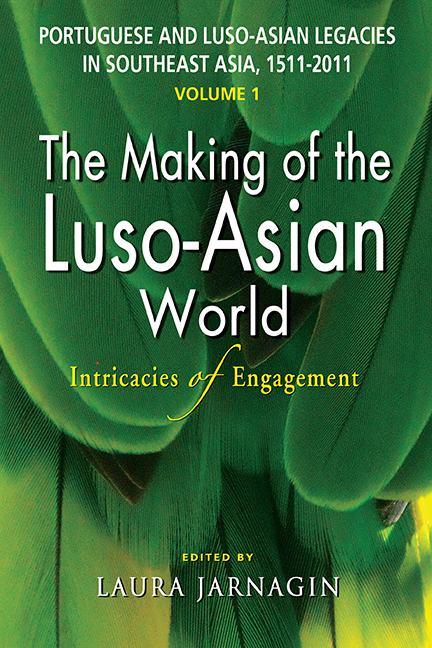 Portuguese and Luso-Asian Legacies in Southeast Asia, 1511–2011, vol. 1
Portuguese and Luso-Asian Legacies in Southeast Asia, 1511–2011, vol. 1 Book contents
- Frontmatter
- Contents
- List of Charts, Figures and Tables
- A Tribute to Glenn Ames
- Preface
- List of Contributors
- Glossary
- Introduction: Towards Clarity through Complexity
- Part One Adaptations and Transitions in the South and Southeast Asian Theatres, Sixteenth through Eighteenth Centuries
- 1 Supplying Simples for the Royal Hospital: An Indo-Portuguese Medicinal Garden in Goa (1520–1830)
- 2 Malacca in the Era of Viceroy Linhares (1629–35)
- 3 From Meliapor to Mylapore, 1662–1749: The Portuguese Presence in São Tomé between the Qutb Shāhī Conquest and Its Incorporation into British Madras
- 4 Eighteenth-Century Diplomatic Relations between Portuguese Macao and Ayutthaya: The 1721 Debt Repayment Embassy from Macao
- 5 Continuities in Bengal's Contact with the Portuguese and Its Legacy: A Community's Future Engangled with the Past
- Part Two Dispersion, Mobility and Demography from the Sixteenth into the Twenty-first Centuries
- Part Three Mixed Legacies: The Portuguese and Luso-Asians in the Twentieth and Twenty-first Centuries
- Bibliography
- Index
2 - Malacca in the Era of Viceroy Linhares (1629–35)
from Part One - Adaptations and Transitions in the South and Southeast Asian Theatres, Sixteenth through Eighteenth Centuries
Published online by Cambridge University Press: 21 October 2015
- Frontmatter
- Contents
- List of Charts, Figures and Tables
- A Tribute to Glenn Ames
- Preface
- List of Contributors
- Glossary
- Introduction: Towards Clarity through Complexity
- Part One Adaptations and Transitions in the South and Southeast Asian Theatres, Sixteenth through Eighteenth Centuries
- 1 Supplying Simples for the Royal Hospital: An Indo-Portuguese Medicinal Garden in Goa (1520–1830)
- 2 Malacca in the Era of Viceroy Linhares (1629–35)
- 3 From Meliapor to Mylapore, 1662–1749: The Portuguese Presence in São Tomé between the Qutb Shāhī Conquest and Its Incorporation into British Madras
- 4 Eighteenth-Century Diplomatic Relations between Portuguese Macao and Ayutthaya: The 1721 Debt Repayment Embassy from Macao
- 5 Continuities in Bengal's Contact with the Portuguese and Its Legacy: A Community's Future Engangled with the Past
- Part Two Dispersion, Mobility and Demography from the Sixteenth into the Twenty-first Centuries
- Part Three Mixed Legacies: The Portuguese and Luso-Asians in the Twentieth and Twenty-first Centuries
- Bibliography
- Index
Summary
On 14 January 1641, after a protracted siege lasting five and a half months, Portuguese Malacca surrendered to the Dutch. The loss of Malacca, which had been in Portuguese hands since its capture by Albuquerque from Sultan Mahmud 140 years earlier, was a crushing blow to the Portuguese. At the time the greatest loss the Estado da Índia had ever suffered in the East, it proved a setback from which there would never be a full recovery. Effectively, it marked the end of Portugal's status as a first-rate power in maritime Asia, especially east of Cape Comorin.
The story of the final siege of Malacca by the Dutch in 1640–41 is well known and need not detain us here. But the build-up towards that climax, particularly in the decade or so preceding it, is less clear. What follows is an investigation into a crucial part of this build-up — the rapidly moving situation at Malacca during the administration of Dom Miguel de Noronha, fourth Conde de Linhares. This viceroy, who held office at Goa from 21 October 1629 to 9 December 1635, was an intelligent and hard-working proconsul, tireless in his efforts to sustain the Estado da Índia. Nevertheless, only five years after his departure, Malacca fell. The questions addressed here are to what extent did Portuguese Malacca cease to be militarily and commercially viable during the course of Linhares's term — and, insofar as this did happen, how and why did it happen?
SEVENTEENTH-CENTURY PORTUGUESE MALACCA
Seventeenth-century Portuguese Malacca consisted of an inner city surrounded by defensive walls, within which were the citadel and the Augustinian, Dominican and Jesuit churches and establishments clustered on and around St Paul's hill. Most of the townspeople lived outside the walls in Malay-style thatched houses, particularly to the north of the river. Here were also orchards, gardens and the dusun, or small rural properties on the fringes of the forest. But there was insufficient arable land in Portuguese-controlled territory for the city to feed itself — it was therefore obliged to import rice and other foodstuffs from Java, Siam and elsewhere in peninsular Malaya. Malacca's population under Linhares remained quite cosmopolitan, but the mixture was rather different from what it had been for much of the sixteenth century. Naturally the indigenous Malays formed a substantial majority, but their political influence was limited and they seldom feature in the Portuguese sources.
- Type
- Chapter
- Information
- Portuguese and Luso-Asian Legacies in Southeast Asia, 1511–2011, vol. 1The Making of the Luso-Asian World: Intricacies of Engagement, pp. 48 - 66Publisher: ISEAS–Yusof Ishak InstitutePrint publication year: 2011
